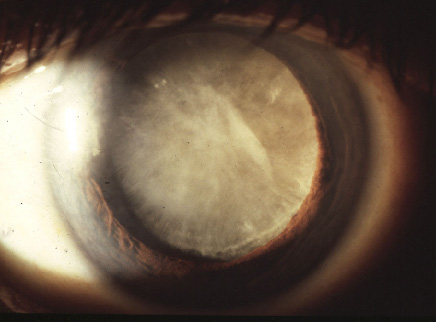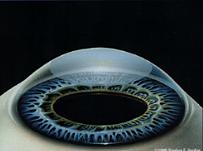How Well You Know The Human Eye? Trivia Quiz

.
- 1.
Most eye surgeries require the removal of the eyeball from the socket.
- A.
False
- B.
True
Correct Answer
A. FalseExplanation
The statement is false because most eye surgeries do not require the removal of the eyeball from the socket. Eye surgeries typically involve procedures that are performed on the surface of the eye or inside the eye, such as cataract surgery, LASIK, or corneal transplant. These surgeries do not involve the removal of the entire eyeball.Rate this question:
-
- 2.
A Cataract is
- A.
A rare tumor of the eye
- B.
A growth in the eye caused by fever
- C.
A contagious skin lesion
- D.
A normal aging change in the lens
Correct Answer
D. A normal aging change in the lensExplanation
A cataract is a normal aging change in the lens of the eye. As people age, the proteins in the lens can start to clump together, causing clouding or opacity in the lens. This clouding can lead to blurry vision, difficulty seeing in low light, and sensitivity to glare. Cataracts are a common condition that typically develop slowly over time and can be treated with surgery to replace the cloudy lens with an artificial one. They are not a tumor, growth caused by fever, or a contagious skin lesion.Rate this question:
-
- 3.
Which of the following is true:
- A.
Each eye sees a totally different image
- B.
One eye sees color, the other sees shades of black and white
- C.
Both eyes see similar images which are then fused into one
- D.
Only the right eye sees in a right-handed person and the left eye in a left-handed person
Correct Answer
C. Both eyes see similar images which are then fused into oneExplanation
Both eyes see similar images which are then fused into one. This is because the visual system in the brain combines the images from both eyes to create a single, unified perception of the world. This process, known as binocular fusion, allows for depth perception and a more detailed and accurate perception of the environment.Rate this question:
-
- 4.
Common causes of eye injuries in young people include all of the following except:
- A.
Bungie cords
- B.
Paintball
- C.
Flipping over eyelids
- D.
Dart guns
Correct Answer
C. Flipping over eyelidsExplanation
Flipping over eyelids is not a common cause of eye injuries in young people. Bungie cords, paintball, and dart guns are all activities that can potentially cause eye injuries due to the high velocity and impact involved. However, flipping over eyelids does not pose a direct risk of eye injury.Rate this question:
-
- 5.
Ultraviolet (UV) radiation has been linked to all of the following except for
- A.
Macular Degeneration
- B.
Cataracts
- C.
Eyelid cancers
- D.
Glaucoma
Correct Answer
D. GlaucomaExplanation
Exposure to ultraviolet (UV) radiation has been linked to various eye conditions, including macular degeneration, cataracts, and eyelid cancers. However, there is no established link between UV radiation and glaucoma. Glaucoma is a condition characterized by increased pressure within the eye, which can damage the optic nerve and lead to vision loss. While UV radiation can cause damage to the eyes, it is not considered a risk factor for developing glaucoma.Rate this question:
-
- 6.
Wearing safety glasses is more painful that getting your eye removed.
- A.
True
- B.
False
Correct Answer
B. FalseExplanation
The given statement is illogical and incorrect. It is not possible for wearing safety glasses to be more painful than getting your eye removed. Wearing safety glasses is a preventive measure to protect the eyes from potential harm and injury. On the other hand, getting your eye removed is a traumatic and irreversible procedure that involves significant pain and potential complications. Therefore, the correct answer is False.Rate this question:
-
- 7.
A medical doctor who treats diseases and performs surgery on the eye is
- A.
An optimist
- B.
An optometrist
- C.
An ophthalmologist
- D.
An optician
- E.
An awfulmologist
Correct Answer
C. An ophthalmologistExplanation
An ophthalmologist is a medical doctor who specializes in the treatment of diseases and performs surgery on the eye. They have extensive knowledge and training in eye care, including the diagnosis and management of various eye conditions. This profession requires a high level of expertise and skill in order to provide comprehensive eye care to patients.Rate this question:
-
- 8.
Cataracts can be seen in
- A.
People over the age of 60
- B.
People under the age of 60
- C.
Newborn Infants
- D.
All of the above
Correct Answer
D. All of the aboveExplanation
Cataracts can be seen in people over the age of 60 due to age-related changes in the lens of the eye. However, cataracts can also occur in people under the age of 60 due to factors such as genetics, trauma, or certain medical conditions. Additionally, newborn infants can also develop cataracts, although this is relatively rare. Therefore, cataracts can be seen in all of the mentioned age groups.Rate this question:
-
- 9.
In glaucoma, the damage to the eye is done by
- A.
High intraocular pressure
- B.
Poor circulation in the eye
- C.
Excessive rubbing by the patient
- D.
Sunlight exposure
Correct Answer
A. High intraocular pressureExplanation
Glaucoma is a condition characterized by damage to the optic nerve, which can lead to vision loss. High intraocular pressure is the main cause of glaucoma. Increased pressure within the eye can damage the optic nerve and impair its function over time. This occurs when the fluid inside the eye, called aqueous humor, is not able to drain properly, causing a buildup of pressure. Therefore, high intraocular pressure is the primary factor responsible for the damage seen in glaucoma.Rate this question:
-
- 10.
In the cornea, the layer that is critical for normal function is
- A.
The Epithelium
- B.
The Epidermis
- C.
The Endothelium
- D.
The Stroma
- E.
The Lens
Correct Answer
C. The EndotheliumExplanation
The endothelium is the correct answer because it is a critical layer in the cornea that helps maintain the cornea's transparency and clarity. It is responsible for regulating fluid balance and removing excess fluid from the cornea, preventing it from becoming swollen and cloudy. The endothelium also helps in maintaining the cornea's shape and thickness, ensuring proper vision.Rate this question:
-
- 11.
What is the cloudy area of the following picture?
- A.
Macular Degeneration
- B.
A Pterygium
- C.
Glaucoma
- D.
A Cataract
- E.
An Ulcer
Correct Answer
D. A CataractExplanation
A cataract is a cloudy area in the lens of the eye, which causes blurred vision. It is the correct answer because the question asks for the cloudy area in the picture, and a cataract fits this description. Macular Degeneration, Pterygium, Glaucoma, and Ulcer do not involve a cloudy area in the eye.Rate this question:
-
- 12.
On the picture below, the clear dome on the top of the eye shown is the
- A.
Iris
- B.
Cornea
- C.
Pupil
- D.
Lens
- E.
Retina
Correct Answer
B. CorneaExplanation
The clear dome on the top of the eye shown in the picture is called the cornea. The cornea is the transparent front part of the eye that covers the iris, pupil, and anterior chamber. It acts as a protective layer and helps to focus light onto the retina at the back of the eye.Rate this question:
-
- 13.
A pterygium is a benign growth caused by sun damage.
- A.
True
- B.
False
Correct Answer
A. TrueExplanation
A pterygium is a benign growth on the eye's conjunctiva that is often caused by excessive exposure to sunlight. This growth is typically pink or flesh-colored and can extend onto the cornea, affecting vision. While it is not cancerous, it can cause discomfort, redness, and irritation. Therefore, the statement that a pterygium is caused by sun damage is true.Rate this question:
-
- 14.
The part of the eye on which images are focused like the film in a camera is
- A.
The Retina
- B.
The Eyelid
- C.
The Lens
- D.
The Cornea
- E.
The Pupil
Correct Answer
A. The RetinaExplanation
The retina is the correct answer because it is the part of the eye where images are focused, similar to how film in a camera captures images. The retina contains specialized cells called photoreceptors that convert light into electrical signals, which are then sent to the brain through the optic nerve for processing and interpretation. The other options, such as the eyelid, lens, cornea, and pupil, are not responsible for focusing images in the same way as the retina.Rate this question:
-
- 15.
A common procedure to correct myopia is
- A.
DSAEK
- B.
PTK
- C.
Cataract Surgery
- D.
DLEK
- E.
LASIK
Correct Answer
E. LASIKExplanation
LASIK (Laser-Assisted In Situ Keratomileusis) is a common procedure used to correct myopia (nearsightedness). During the procedure, a laser is used to reshape the cornea, allowing light to properly focus on the retina, resulting in improved vision. LASIK is a popular choice for myopia correction due to its effectiveness, quick recovery time, and minimal discomfort. It is a safe and reliable surgical option that has been successfully used for many years.Rate this question:
-
- 16.
The structure which connects the eye to the brain like a fiber-optic cable is:
- A.
The Retina
- B.
The Optic Nerve
- C.
The Stroma
- D.
The Cornea
- E.
The Endothelium
Correct Answer
B. The Optic NerveExplanation
The optic nerve is the correct answer because it is the structure that connects the eye to the brain, transmitting visual information from the retina to the brain. It functions like a fiber-optic cable, carrying electrical signals generated by the photoreceptor cells in the retina to the visual processing centers in the brain.Rate this question:
-
- 17.
Which structure produces tears during crying?
- A.
Meibomian Gland
- B.
Eyelash
- C.
Lacrimal Gland
- D.
Lens
- E.
Cornea
Correct Answer
C. Lacrimal GlandExplanation
The lacrimal gland is responsible for producing tears during crying. Tears are essential for lubricating and protecting the eyes, and the lacrimal gland is located above the outer corner of each eye. When a person cries, the lacrimal gland releases tears that flow down the surface of the eye, helping to wash away any irritants and providing emotional relief.Rate this question:
-
- 18.
Which structure regulates the amount of light entering the eye?
- A.
Cornea
- B.
Retina
- C.
Lens
- D.
Pupil
- E.
Sclera
Correct Answer
D. PupilExplanation
The pupil is the correct answer because it is the structure that regulates the amount of light entering the eye. The pupil is the small, adjustable opening in the center of the iris that controls the amount of light that enters the eye. It can dilate or constrict in response to the amount of light present, allowing more or less light to enter the eye and reach the retina for processing.Rate this question:
-
Quiz Review Timeline +
Our quizzes are rigorously reviewed, monitored and continuously updated by our expert board to maintain accuracy, relevance, and timeliness.
-
Current Version
-
Mar 22, 2023Quiz Edited by
ProProfs Editorial Team -
Nov 22, 2009Quiz Created by
Chpolack
- Aura Quizzes
- Axial Skeleton Quizzes
- Body Mechanics Quizzes
- Body Parts Quizzes
- Body System Quizzes
- Chest Quizzes
- Ear Quizzes
- Endocrine Quizzes
- Feet Quizzes
- Gland Quizzes
- Limb Quizzes
- Musculoskeletal Quizzes
- Pain Quizzes
- Pharmacodynamics Quizzes
- Piercing Quizzes
- Spanish Body Parts Quizzes
- Thorax Quizzes
- Urine Quizzes
 Back to top
Back to top




